Financial & Economic Literacy for Managers Assignment Report
VerifiedAdded on 2019/12/18
|20
|3822
|62
Report
AI Summary
This report on financial and economic literacy for managers addresses a range of topics, starting with the impact of globalization on firms and consumers, and extending to the analysis of market structures, including imperfect competition and monopolies. It delves into the movement of the demand curve, economies and diseconomies of scale, and determinants of supply in the retail sector, alongside the concepts of substitute and complementary products. The report further examines governmental policies, such as environmental regulations, and explains the circular flow of income and the concept of unemployment. It then moves on to cover the identification and analysis of four basic financial statements, relevant and irrelevant costs, and the application of financial ratios. Finally, it explores concepts such as risk and return, capital structure, and the calculation of amortization schedules, concluding with a discussion on project valuation.
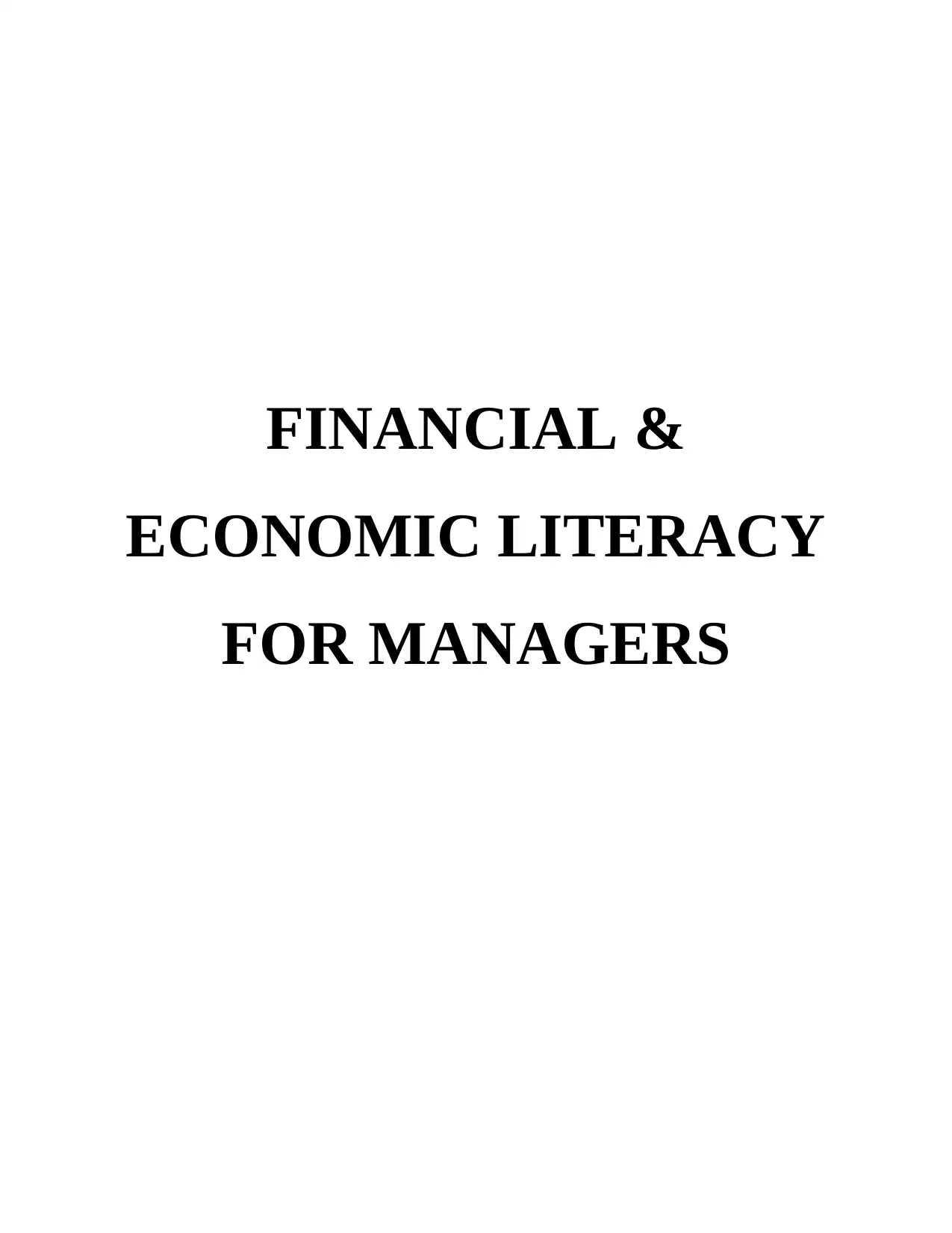
FINANCIAL &
ECONOMIC LITERACY
FOR MANAGERS
ECONOMIC LITERACY
FOR MANAGERS
Paraphrase This Document
Need a fresh take? Get an instant paraphrase of this document with our AI Paraphraser
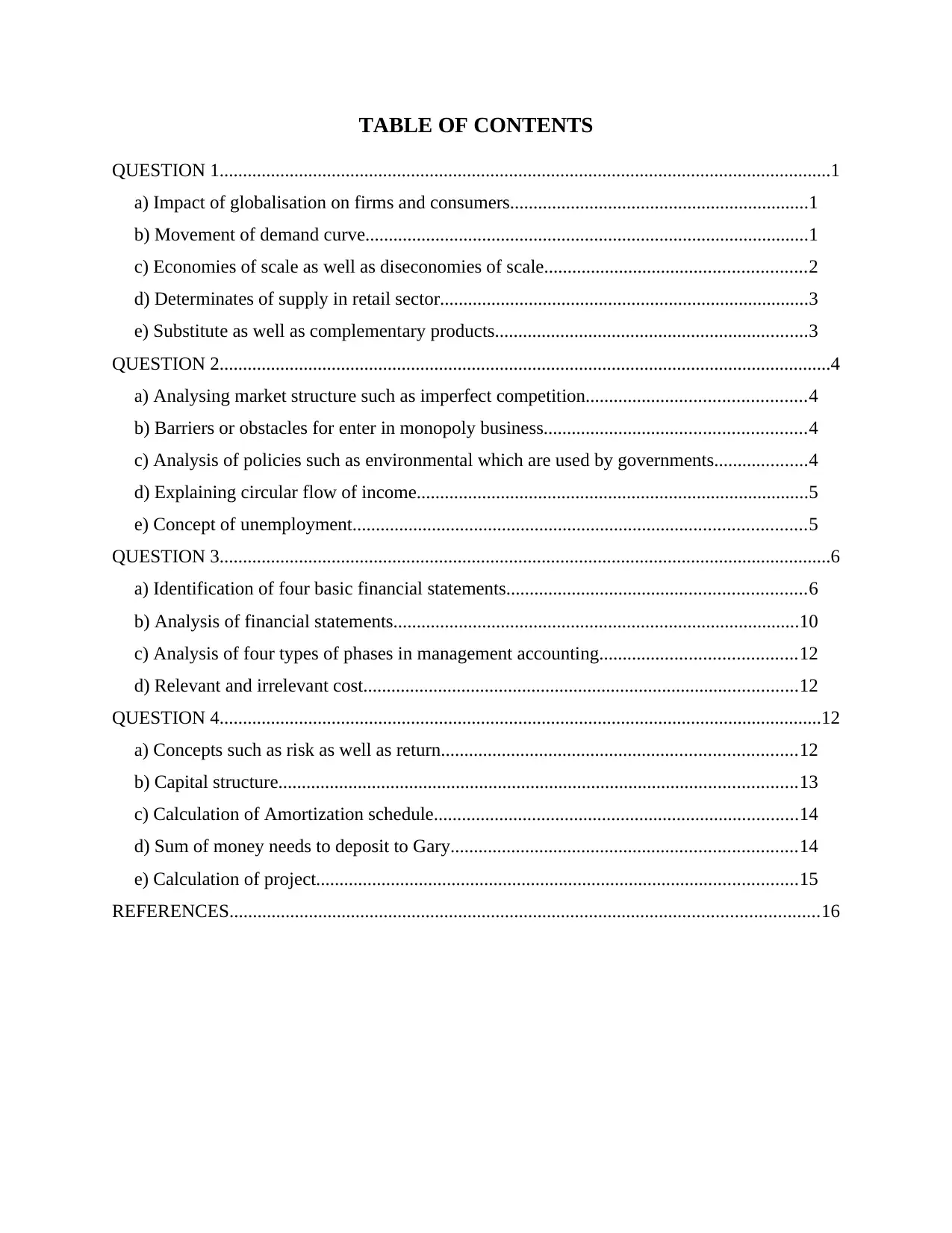
TABLE OF CONTENTS
QUESTION 1...................................................................................................................................1
a) Impact of globalisation on firms and consumers................................................................1
b) Movement of demand curve...............................................................................................1
c) Economies of scale as well as diseconomies of scale........................................................2
d) Determinates of supply in retail sector...............................................................................3
e) Substitute as well as complementary products...................................................................3
QUESTION 2...................................................................................................................................4
a) Analysing market structure such as imperfect competition...............................................4
b) Barriers or obstacles for enter in monopoly business........................................................4
c) Analysis of policies such as environmental which are used by governments....................4
d) Explaining circular flow of income....................................................................................5
e) Concept of unemployment.................................................................................................5
QUESTION 3...................................................................................................................................6
a) Identification of four basic financial statements................................................................6
b) Analysis of financial statements.......................................................................................10
c) Analysis of four types of phases in management accounting..........................................12
d) Relevant and irrelevant cost.............................................................................................12
QUESTION 4.................................................................................................................................12
a) Concepts such as risk as well as return............................................................................12
b) Capital structure...............................................................................................................13
c) Calculation of Amortization schedule..............................................................................14
d) Sum of money needs to deposit to Gary..........................................................................14
e) Calculation of project.......................................................................................................15
REFERENCES..............................................................................................................................16
QUESTION 1...................................................................................................................................1
a) Impact of globalisation on firms and consumers................................................................1
b) Movement of demand curve...............................................................................................1
c) Economies of scale as well as diseconomies of scale........................................................2
d) Determinates of supply in retail sector...............................................................................3
e) Substitute as well as complementary products...................................................................3
QUESTION 2...................................................................................................................................4
a) Analysing market structure such as imperfect competition...............................................4
b) Barriers or obstacles for enter in monopoly business........................................................4
c) Analysis of policies such as environmental which are used by governments....................4
d) Explaining circular flow of income....................................................................................5
e) Concept of unemployment.................................................................................................5
QUESTION 3...................................................................................................................................6
a) Identification of four basic financial statements................................................................6
b) Analysis of financial statements.......................................................................................10
c) Analysis of four types of phases in management accounting..........................................12
d) Relevant and irrelevant cost.............................................................................................12
QUESTION 4.................................................................................................................................12
a) Concepts such as risk as well as return............................................................................12
b) Capital structure...............................................................................................................13
c) Calculation of Amortization schedule..............................................................................14
d) Sum of money needs to deposit to Gary..........................................................................14
e) Calculation of project.......................................................................................................15
REFERENCES..............................................................................................................................16
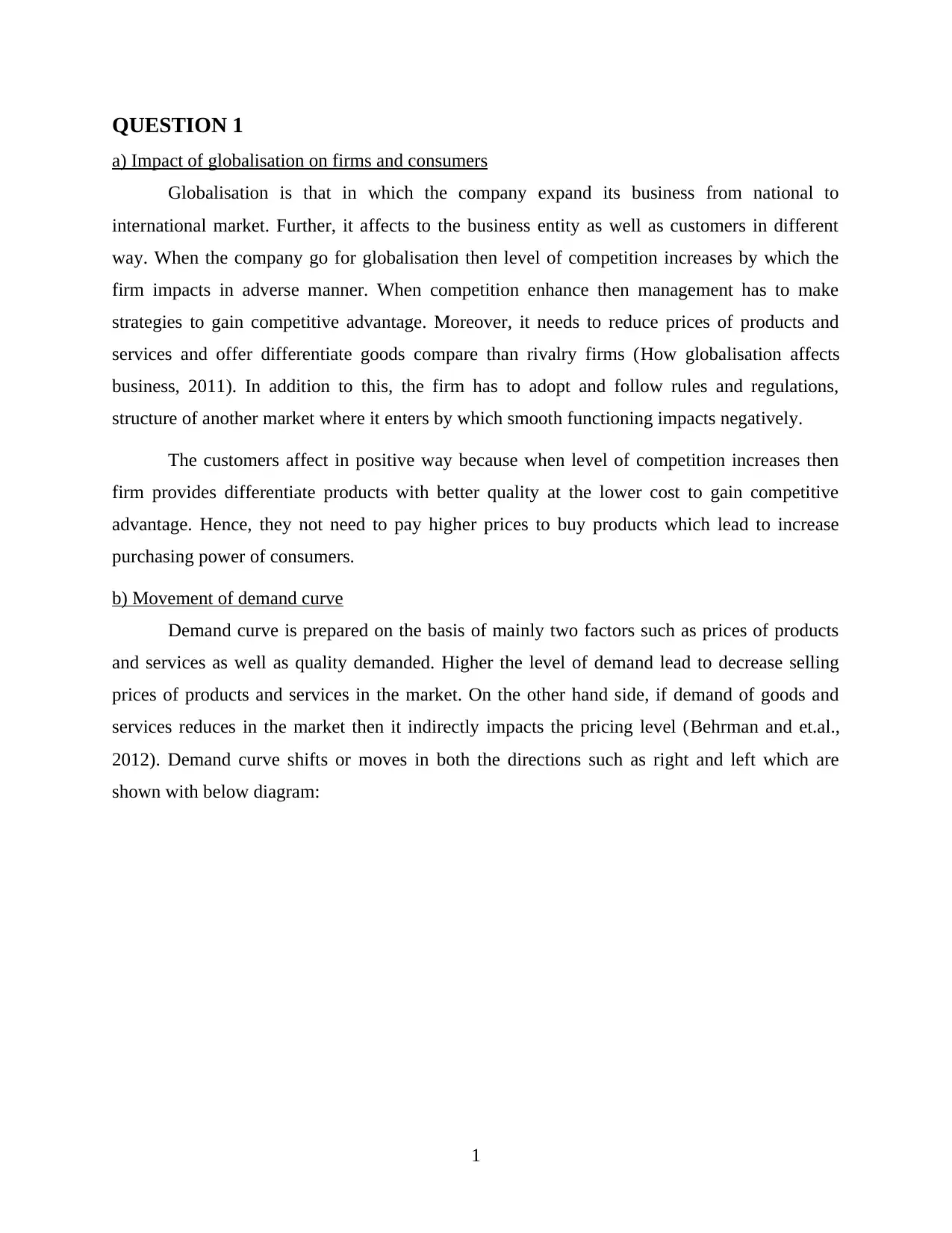
QUESTION 1
a) Impact of globalisation on firms and consumers
Globalisation is that in which the company expand its business from national to
international market. Further, it affects to the business entity as well as customers in different
way. When the company go for globalisation then level of competition increases by which the
firm impacts in adverse manner. When competition enhance then management has to make
strategies to gain competitive advantage. Moreover, it needs to reduce prices of products and
services and offer differentiate goods compare than rivalry firms (How globalisation affects
business, 2011). In addition to this, the firm has to adopt and follow rules and regulations,
structure of another market where it enters by which smooth functioning impacts negatively.
The customers affect in positive way because when level of competition increases then
firm provides differentiate products with better quality at the lower cost to gain competitive
advantage. Hence, they not need to pay higher prices to buy products which lead to increase
purchasing power of consumers.
b) Movement of demand curve
Demand curve is prepared on the basis of mainly two factors such as prices of products
and services as well as quality demanded. Higher the level of demand lead to decrease selling
prices of products and services in the market. On the other hand side, if demand of goods and
services reduces in the market then it indirectly impacts the pricing level (Behrman and et.al.,
2012). Demand curve shifts or moves in both the directions such as right and left which are
shown with below diagram:
1
a) Impact of globalisation on firms and consumers
Globalisation is that in which the company expand its business from national to
international market. Further, it affects to the business entity as well as customers in different
way. When the company go for globalisation then level of competition increases by which the
firm impacts in adverse manner. When competition enhance then management has to make
strategies to gain competitive advantage. Moreover, it needs to reduce prices of products and
services and offer differentiate goods compare than rivalry firms (How globalisation affects
business, 2011). In addition to this, the firm has to adopt and follow rules and regulations,
structure of another market where it enters by which smooth functioning impacts negatively.
The customers affect in positive way because when level of competition increases then
firm provides differentiate products with better quality at the lower cost to gain competitive
advantage. Hence, they not need to pay higher prices to buy products which lead to increase
purchasing power of consumers.
b) Movement of demand curve
Demand curve is prepared on the basis of mainly two factors such as prices of products
and services as well as quality demanded. Higher the level of demand lead to decrease selling
prices of products and services in the market. On the other hand side, if demand of goods and
services reduces in the market then it indirectly impacts the pricing level (Behrman and et.al.,
2012). Demand curve shifts or moves in both the directions such as right and left which are
shown with below diagram:
1
⊘ This is a preview!⊘
Do you want full access?
Subscribe today to unlock all pages.

Trusted by 1+ million students worldwide
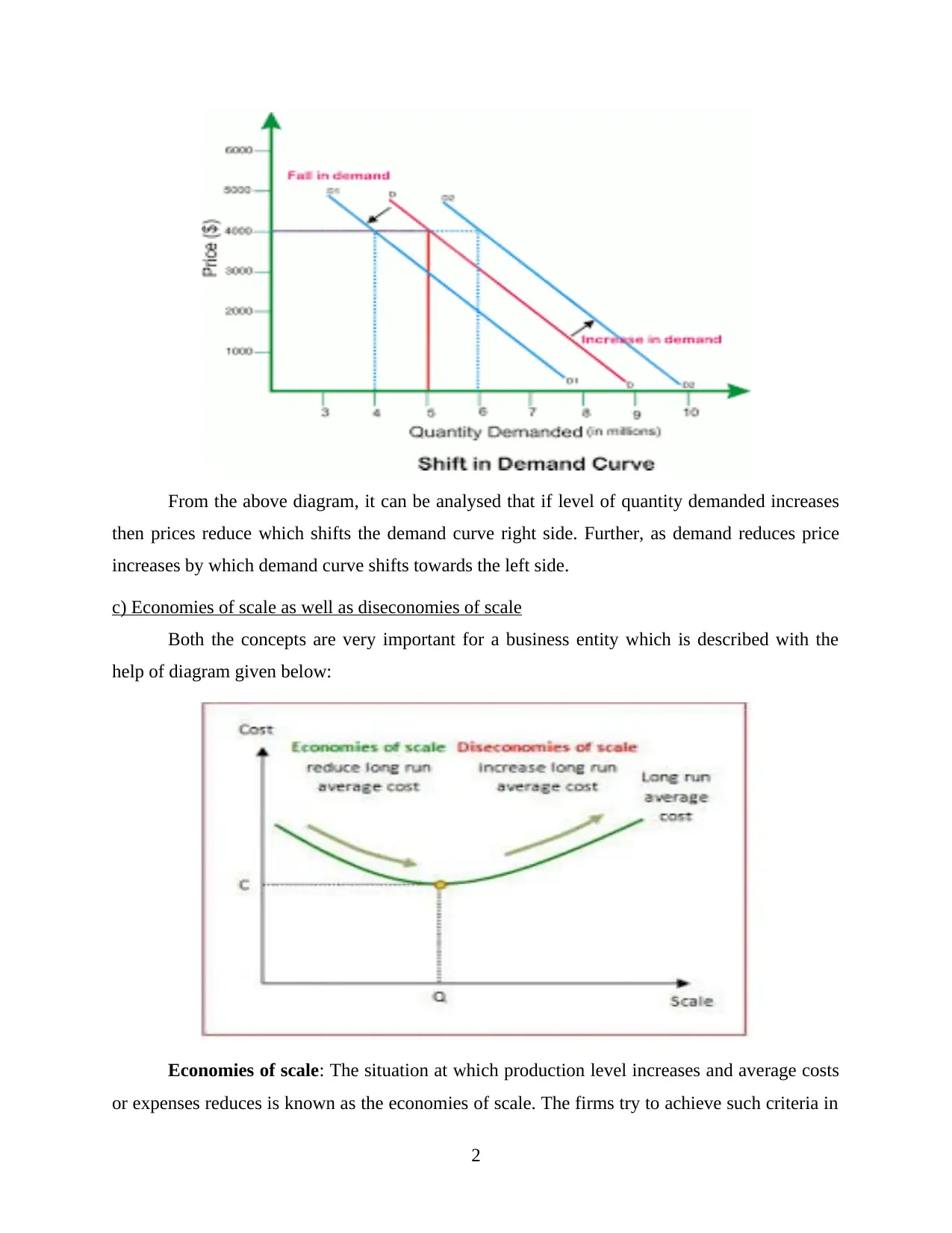
From the above diagram, it can be analysed that if level of quantity demanded increases
then prices reduce which shifts the demand curve right side. Further, as demand reduces price
increases by which demand curve shifts towards the left side.
c) Economies of scale as well as diseconomies of scale
Both the concepts are very important for a business entity which is described with the
help of diagram given below:
Economies of scale: The situation at which production level increases and average costs
or expenses reduces is known as the economies of scale. The firms try to achieve such criteria in
2
then prices reduce which shifts the demand curve right side. Further, as demand reduces price
increases by which demand curve shifts towards the left side.
c) Economies of scale as well as diseconomies of scale
Both the concepts are very important for a business entity which is described with the
help of diagram given below:
Economies of scale: The situation at which production level increases and average costs
or expenses reduces is known as the economies of scale. The firms try to achieve such criteria in
2
Paraphrase This Document
Need a fresh take? Get an instant paraphrase of this document with our AI Paraphraser
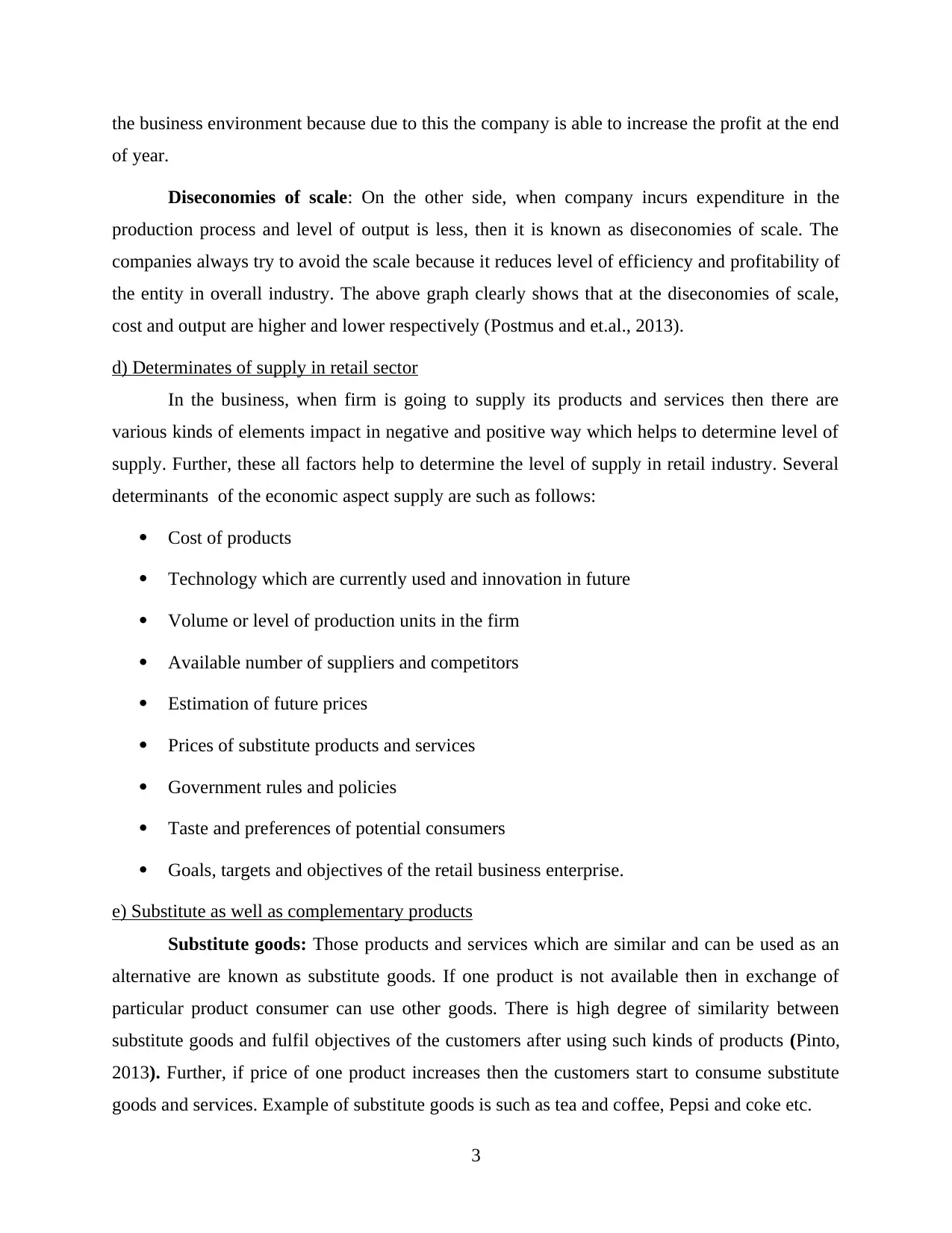
the business environment because due to this the company is able to increase the profit at the end
of year.
Diseconomies of scale: On the other side, when company incurs expenditure in the
production process and level of output is less, then it is known as diseconomies of scale. The
companies always try to avoid the scale because it reduces level of efficiency and profitability of
the entity in overall industry. The above graph clearly shows that at the diseconomies of scale,
cost and output are higher and lower respectively (Postmus and et.al., 2013).
d) Determinates of supply in retail sector
In the business, when firm is going to supply its products and services then there are
various kinds of elements impact in negative and positive way which helps to determine level of
supply. Further, these all factors help to determine the level of supply in retail industry. Several
determinants of the economic aspect supply are such as follows:
Cost of products
Technology which are currently used and innovation in future
Volume or level of production units in the firm
Available number of suppliers and competitors
Estimation of future prices
Prices of substitute products and services
Government rules and policies
Taste and preferences of potential consumers
Goals, targets and objectives of the retail business enterprise.
e) Substitute as well as complementary products
Substitute goods: Those products and services which are similar and can be used as an
alternative are known as substitute goods. If one product is not available then in exchange of
particular product consumer can use other goods. There is high degree of similarity between
substitute goods and fulfil objectives of the customers after using such kinds of products (Pinto,
2013). Further, if price of one product increases then the customers start to consume substitute
goods and services. Example of substitute goods is such as tea and coffee, Pepsi and coke etc.
3
of year.
Diseconomies of scale: On the other side, when company incurs expenditure in the
production process and level of output is less, then it is known as diseconomies of scale. The
companies always try to avoid the scale because it reduces level of efficiency and profitability of
the entity in overall industry. The above graph clearly shows that at the diseconomies of scale,
cost and output are higher and lower respectively (Postmus and et.al., 2013).
d) Determinates of supply in retail sector
In the business, when firm is going to supply its products and services then there are
various kinds of elements impact in negative and positive way which helps to determine level of
supply. Further, these all factors help to determine the level of supply in retail industry. Several
determinants of the economic aspect supply are such as follows:
Cost of products
Technology which are currently used and innovation in future
Volume or level of production units in the firm
Available number of suppliers and competitors
Estimation of future prices
Prices of substitute products and services
Government rules and policies
Taste and preferences of potential consumers
Goals, targets and objectives of the retail business enterprise.
e) Substitute as well as complementary products
Substitute goods: Those products and services which are similar and can be used as an
alternative are known as substitute goods. If one product is not available then in exchange of
particular product consumer can use other goods. There is high degree of similarity between
substitute goods and fulfil objectives of the customers after using such kinds of products (Pinto,
2013). Further, if price of one product increases then the customers start to consume substitute
goods and services. Example of substitute goods is such as tea and coffee, Pepsi and coke etc.
3
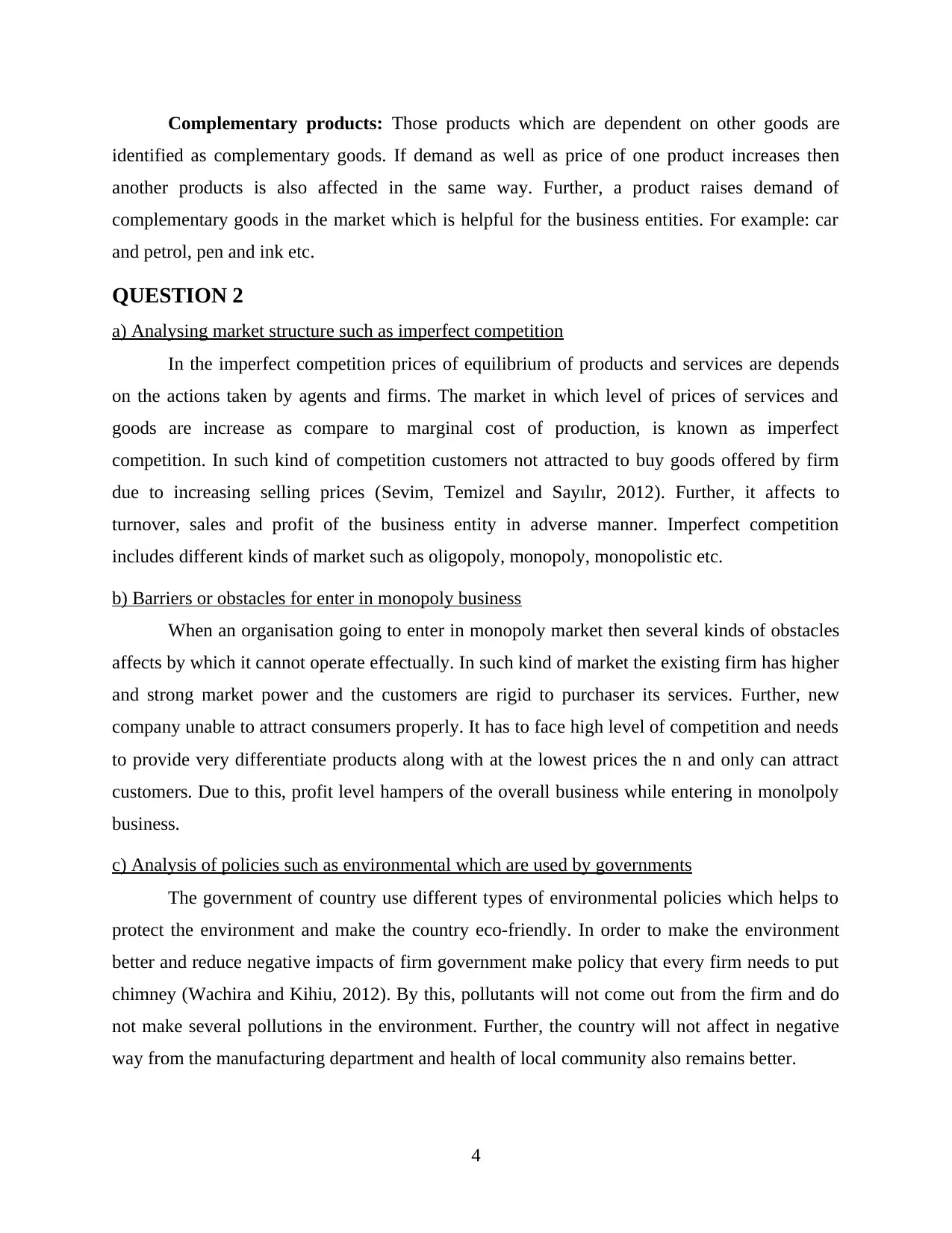
Complementary products: Those products which are dependent on other goods are
identified as complementary goods. If demand as well as price of one product increases then
another products is also affected in the same way. Further, a product raises demand of
complementary goods in the market which is helpful for the business entities. For example: car
and petrol, pen and ink etc.
QUESTION 2
a) Analysing market structure such as imperfect competition
In the imperfect competition prices of equilibrium of products and services are depends
on the actions taken by agents and firms. The market in which level of prices of services and
goods are increase as compare to marginal cost of production, is known as imperfect
competition. In such kind of competition customers not attracted to buy goods offered by firm
due to increasing selling prices (Sevim, Temizel and Sayılır, 2012). Further, it affects to
turnover, sales and profit of the business entity in adverse manner. Imperfect competition
includes different kinds of market such as oligopoly, monopoly, monopolistic etc.
b) Barriers or obstacles for enter in monopoly business
When an organisation going to enter in monopoly market then several kinds of obstacles
affects by which it cannot operate effectually. In such kind of market the existing firm has higher
and strong market power and the customers are rigid to purchaser its services. Further, new
company unable to attract consumers properly. It has to face high level of competition and needs
to provide very differentiate products along with at the lowest prices the n and only can attract
customers. Due to this, profit level hampers of the overall business while entering in monolpoly
business.
c) Analysis of policies such as environmental which are used by governments
The government of country use different types of environmental policies which helps to
protect the environment and make the country eco-friendly. In order to make the environment
better and reduce negative impacts of firm government make policy that every firm needs to put
chimney (Wachira and Kihiu, 2012). By this, pollutants will not come out from the firm and do
not make several pollutions in the environment. Further, the country will not affect in negative
way from the manufacturing department and health of local community also remains better.
4
identified as complementary goods. If demand as well as price of one product increases then
another products is also affected in the same way. Further, a product raises demand of
complementary goods in the market which is helpful for the business entities. For example: car
and petrol, pen and ink etc.
QUESTION 2
a) Analysing market structure such as imperfect competition
In the imperfect competition prices of equilibrium of products and services are depends
on the actions taken by agents and firms. The market in which level of prices of services and
goods are increase as compare to marginal cost of production, is known as imperfect
competition. In such kind of competition customers not attracted to buy goods offered by firm
due to increasing selling prices (Sevim, Temizel and Sayılır, 2012). Further, it affects to
turnover, sales and profit of the business entity in adverse manner. Imperfect competition
includes different kinds of market such as oligopoly, monopoly, monopolistic etc.
b) Barriers or obstacles for enter in monopoly business
When an organisation going to enter in monopoly market then several kinds of obstacles
affects by which it cannot operate effectually. In such kind of market the existing firm has higher
and strong market power and the customers are rigid to purchaser its services. Further, new
company unable to attract consumers properly. It has to face high level of competition and needs
to provide very differentiate products along with at the lowest prices the n and only can attract
customers. Due to this, profit level hampers of the overall business while entering in monolpoly
business.
c) Analysis of policies such as environmental which are used by governments
The government of country use different types of environmental policies which helps to
protect the environment and make the country eco-friendly. In order to make the environment
better and reduce negative impacts of firm government make policy that every firm needs to put
chimney (Wachira and Kihiu, 2012). By this, pollutants will not come out from the firm and do
not make several pollutions in the environment. Further, the country will not affect in negative
way from the manufacturing department and health of local community also remains better.
4
⊘ This is a preview!⊘
Do you want full access?
Subscribe today to unlock all pages.

Trusted by 1+ million students worldwide
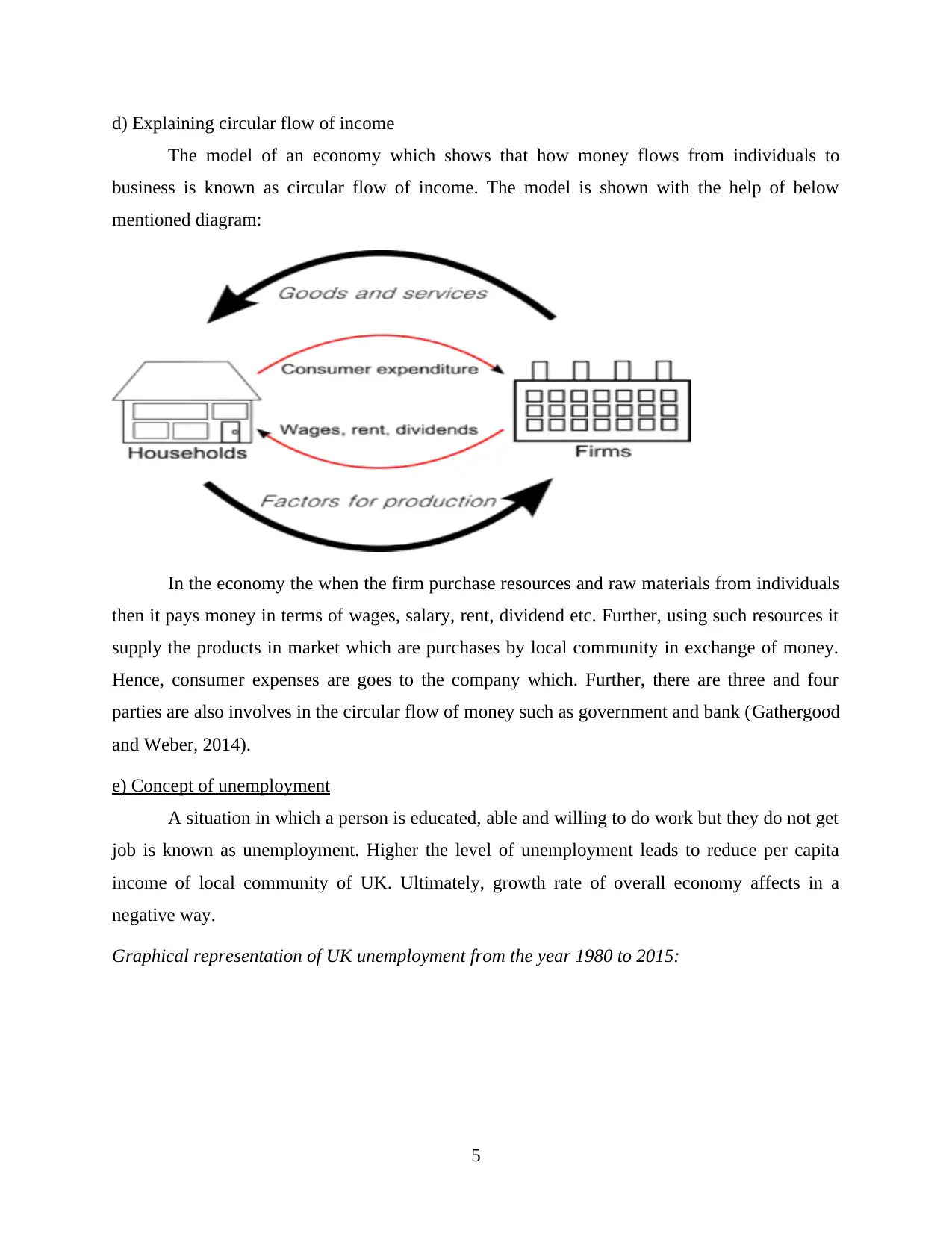
d) Explaining circular flow of income
The model of an economy which shows that how money flows from individuals to
business is known as circular flow of income. The model is shown with the help of below
mentioned diagram:
In the economy the when the firm purchase resources and raw materials from individuals
then it pays money in terms of wages, salary, rent, dividend etc. Further, using such resources it
supply the products in market which are purchases by local community in exchange of money.
Hence, consumer expenses are goes to the company which. Further, there are three and four
parties are also involves in the circular flow of money such as government and bank (Gathergood
and Weber, 2014).
e) Concept of unemployment
A situation in which a person is educated, able and willing to do work but they do not get
job is known as unemployment. Higher the level of unemployment leads to reduce per capita
income of local community of UK. Ultimately, growth rate of overall economy affects in a
negative way.
Graphical representation of UK unemployment from the year 1980 to 2015:
5
The model of an economy which shows that how money flows from individuals to
business is known as circular flow of income. The model is shown with the help of below
mentioned diagram:
In the economy the when the firm purchase resources and raw materials from individuals
then it pays money in terms of wages, salary, rent, dividend etc. Further, using such resources it
supply the products in market which are purchases by local community in exchange of money.
Hence, consumer expenses are goes to the company which. Further, there are three and four
parties are also involves in the circular flow of money such as government and bank (Gathergood
and Weber, 2014).
e) Concept of unemployment
A situation in which a person is educated, able and willing to do work but they do not get
job is known as unemployment. Higher the level of unemployment leads to reduce per capita
income of local community of UK. Ultimately, growth rate of overall economy affects in a
negative way.
Graphical representation of UK unemployment from the year 1980 to 2015:
5
Paraphrase This Document
Need a fresh take? Get an instant paraphrase of this document with our AI Paraphraser
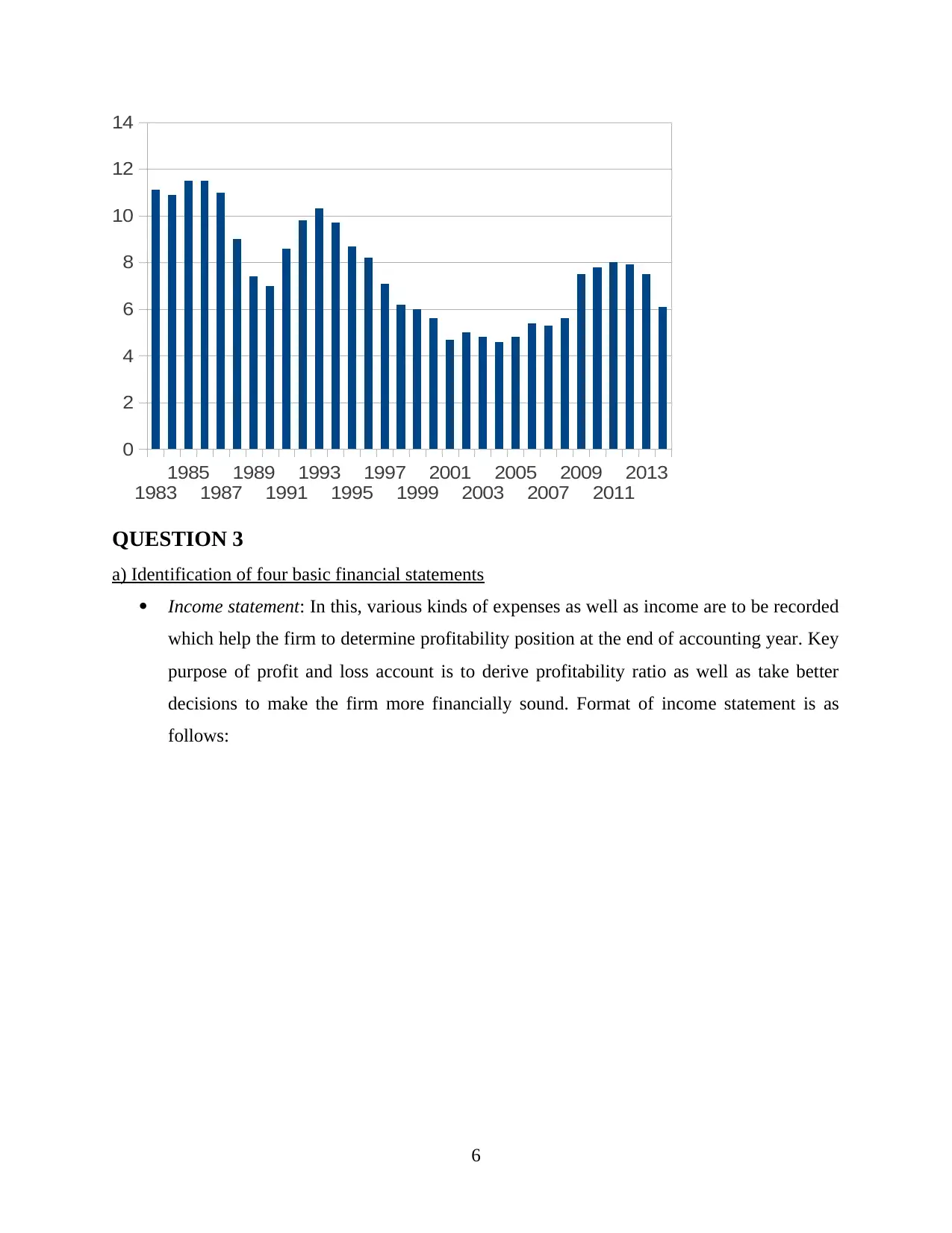
1983
1985
1987
1989
1991
1993
1995
1997
1999
2001
2003
2005
2007
2009
2011
2013
0
2
4
6
8
10
12
14
QUESTION 3
a) Identification of four basic financial statements
Income statement: In this, various kinds of expenses as well as income are to be recorded
which help the firm to determine profitability position at the end of accounting year. Key
purpose of profit and loss account is to derive profitability ratio as well as take better
decisions to make the firm more financially sound. Format of income statement is as
follows:
6
1985
1987
1989
1991
1993
1995
1997
1999
2001
2003
2005
2007
2009
2011
2013
0
2
4
6
8
10
12
14
QUESTION 3
a) Identification of four basic financial statements
Income statement: In this, various kinds of expenses as well as income are to be recorded
which help the firm to determine profitability position at the end of accounting year. Key
purpose of profit and loss account is to derive profitability ratio as well as take better
decisions to make the firm more financially sound. Format of income statement is as
follows:
6
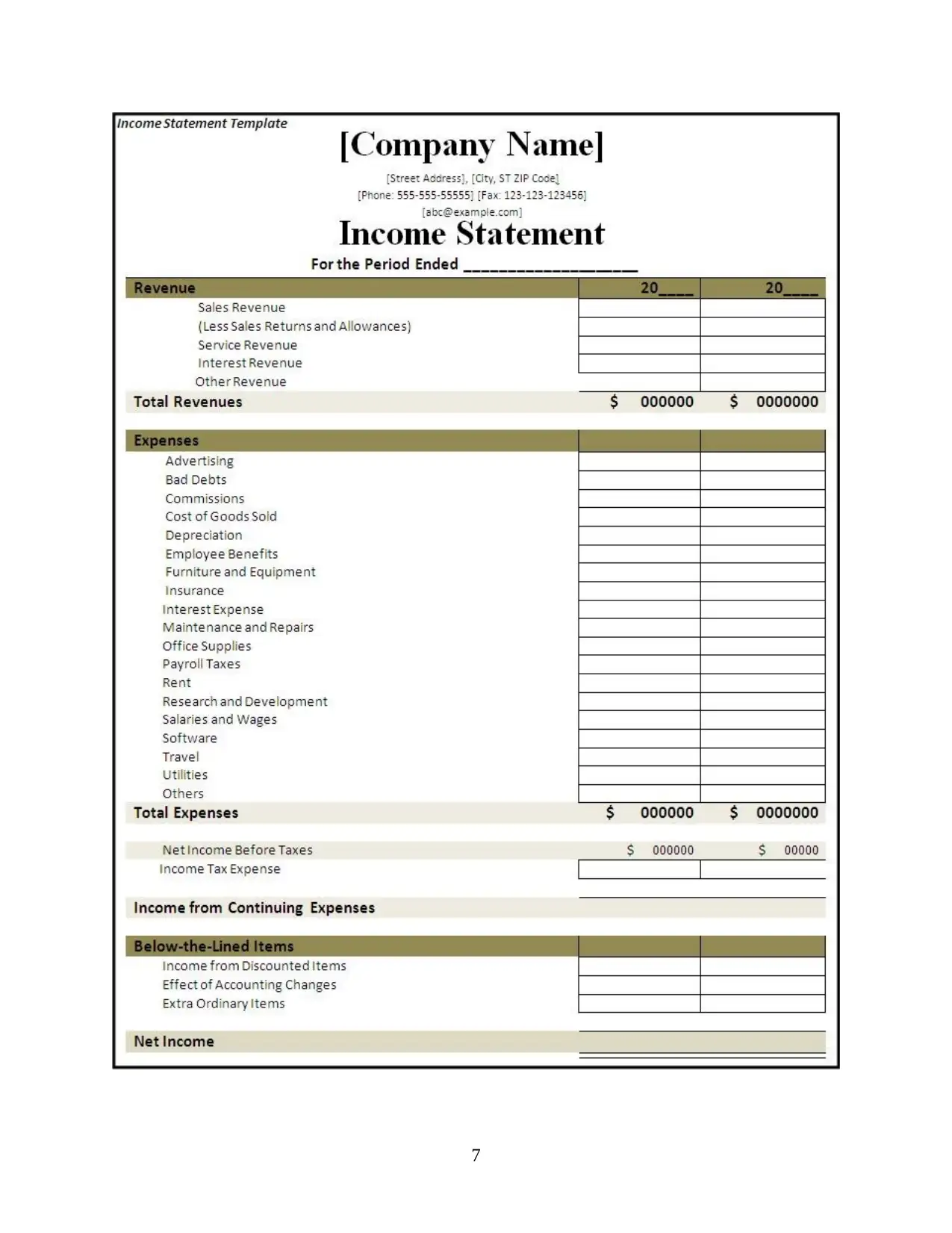
7
⊘ This is a preview!⊘
Do you want full access?
Subscribe today to unlock all pages.

Trusted by 1+ million students worldwide
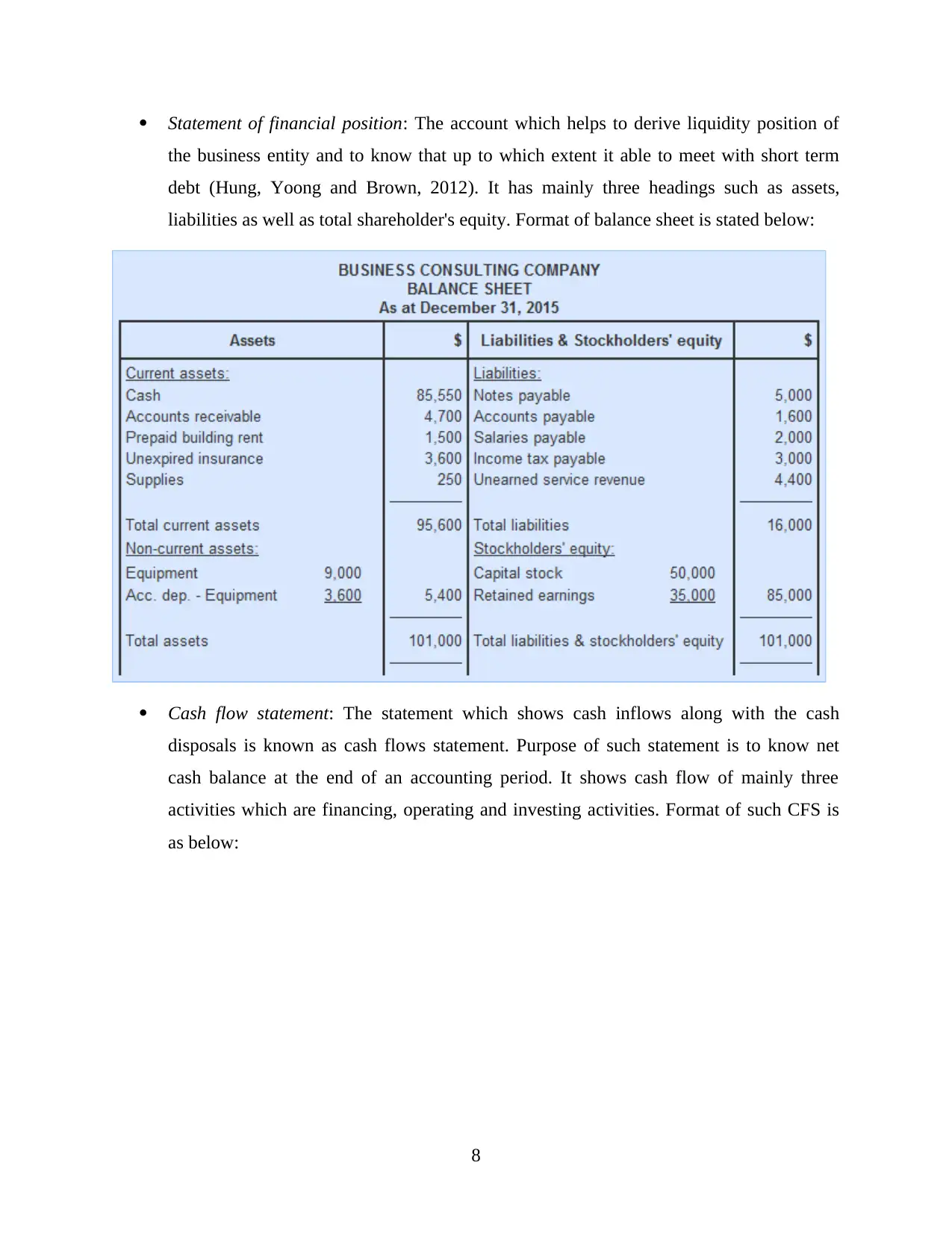
Statement of financial position: The account which helps to derive liquidity position of
the business entity and to know that up to which extent it able to meet with short term
debt (Hung, Yoong and Brown, 2012). It has mainly three headings such as assets,
liabilities as well as total shareholder's equity. Format of balance sheet is stated below:
Cash flow statement: The statement which shows cash inflows along with the cash
disposals is known as cash flows statement. Purpose of such statement is to know net
cash balance at the end of an accounting period. It shows cash flow of mainly three
activities which are financing, operating and investing activities. Format of such CFS is
as below:
8
the business entity and to know that up to which extent it able to meet with short term
debt (Hung, Yoong and Brown, 2012). It has mainly three headings such as assets,
liabilities as well as total shareholder's equity. Format of balance sheet is stated below:
Cash flow statement: The statement which shows cash inflows along with the cash
disposals is known as cash flows statement. Purpose of such statement is to know net
cash balance at the end of an accounting period. It shows cash flow of mainly three
activities which are financing, operating and investing activities. Format of such CFS is
as below:
8
Paraphrase This Document
Need a fresh take? Get an instant paraphrase of this document with our AI Paraphraser
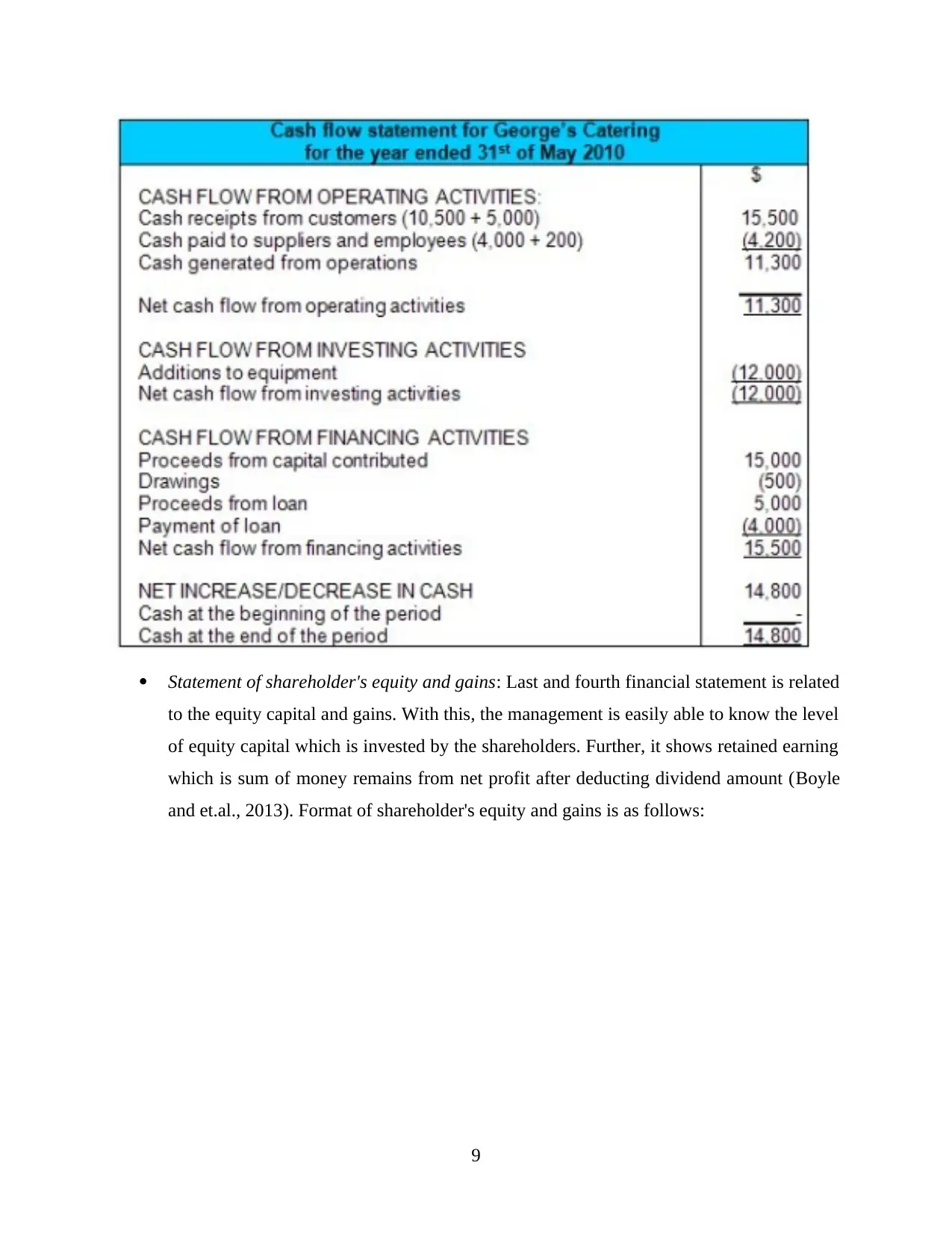
Statement of shareholder's equity and gains: Last and fourth financial statement is related
to the equity capital and gains. With this, the management is easily able to know the level
of equity capital which is invested by the shareholders. Further, it shows retained earning
which is sum of money remains from net profit after deducting dividend amount (Boyle
and et.al., 2013). Format of shareholder's equity and gains is as follows:
9
to the equity capital and gains. With this, the management is easily able to know the level
of equity capital which is invested by the shareholders. Further, it shows retained earning
which is sum of money remains from net profit after deducting dividend amount (Boyle
and et.al., 2013). Format of shareholder's equity and gains is as follows:
9
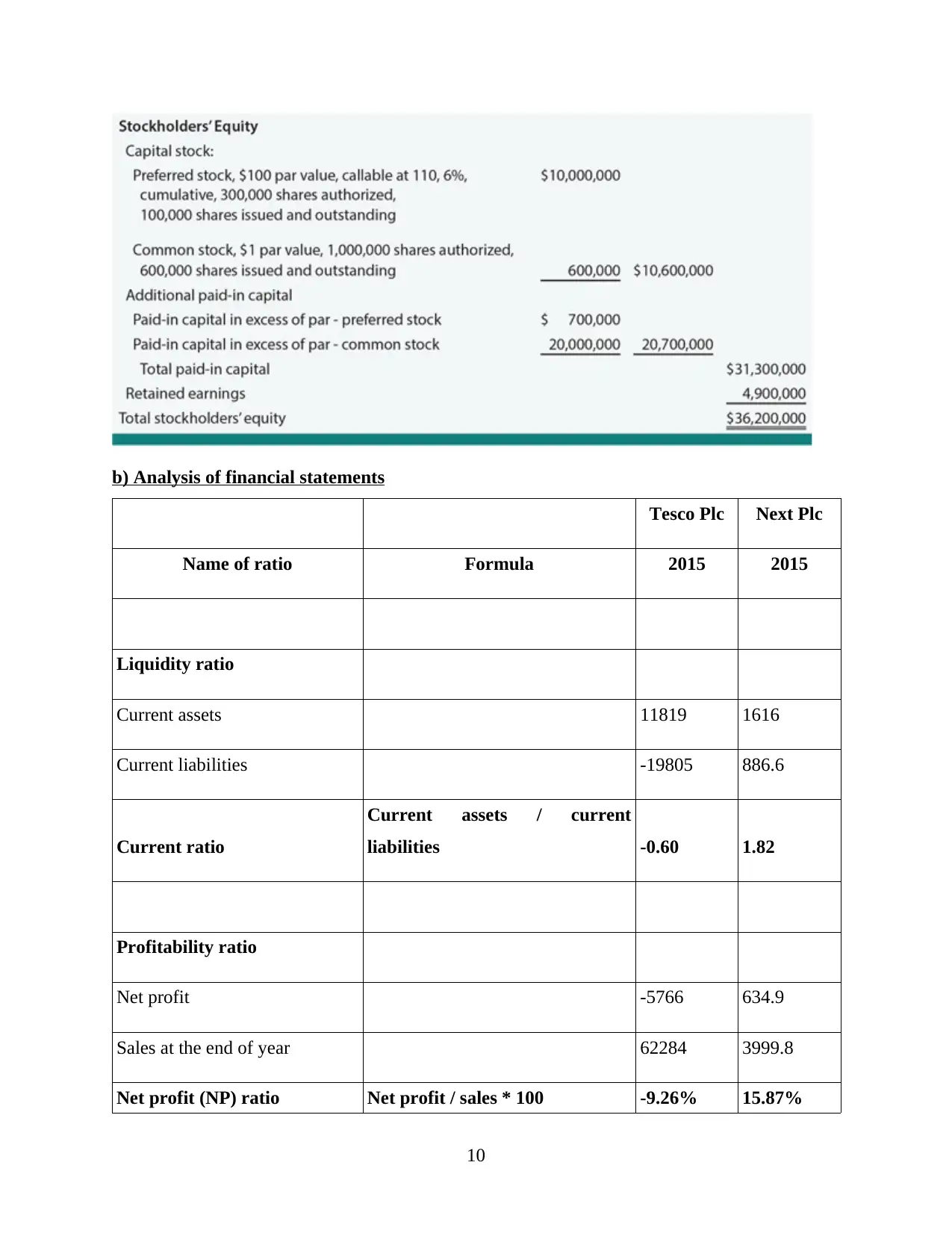
b) Analysis of financial statements
Tesco Plc Next Plc
Name of ratio Formula 2015 2015
Liquidity ratio
Current assets 11819 1616
Current liabilities -19805 886.6
Current ratio
Current assets / current
liabilities -0.60 1.82
Profitability ratio
Net profit -5766 634.9
Sales at the end of year 62284 3999.8
Net profit (NP) ratio Net profit / sales * 100 -9.26% 15.87%
10
Tesco Plc Next Plc
Name of ratio Formula 2015 2015
Liquidity ratio
Current assets 11819 1616
Current liabilities -19805 886.6
Current ratio
Current assets / current
liabilities -0.60 1.82
Profitability ratio
Net profit -5766 634.9
Sales at the end of year 62284 3999.8
Net profit (NP) ratio Net profit / sales * 100 -9.26% 15.87%
10
⊘ This is a preview!⊘
Do you want full access?
Subscribe today to unlock all pages.

Trusted by 1+ million students worldwide
1 out of 20
Related Documents
Your All-in-One AI-Powered Toolkit for Academic Success.
+13062052269
info@desklib.com
Available 24*7 on WhatsApp / Email
![[object Object]](/_next/static/media/star-bottom.7253800d.svg)
Unlock your academic potential
Copyright © 2020–2025 A2Z Services. All Rights Reserved. Developed and managed by ZUCOL.





